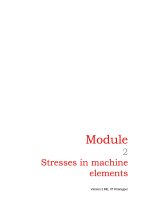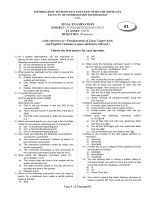Fundamentals of Wireless Communication doc
Bạn đang xem bản rút gọn của tài liệu. Xem và tải ngay bản đầy đủ của tài liệu tại đây (948.06 KB, 30 trang )
2: The Wireless Channel
Fundamentals of Wireless Communication, Tse&Viswanath
Fundamentals of
Wireless Communication
David Tse
2: The Wireless Channel
Fundamentals of Wireless Communication, Tse&Viswanath
1. Introduction
3
2: The Wireless Channel
Fundamentals of Wireless Communication, Tse&Viswanath
Course Objective
•
Past decade has seen a surge of research activities in
the field of wireless communication.
•
Emerging from this research thrust are new points of
view on how to communicate effectively over wireless
channels.
•
The goal of this course is to study in a unified way the
fundamentals as well as the new research
developments.
•
The concepts are illustrated using examples from
several modern wireless systems (GSM, IS-95, CDMA
2000 1x EV-DO, Flarion's Flash OFDM, ArrayComm
systems.)
4
2: The Wireless Channel
Fundamentals of Wireless Communication, Tse&Viswanath
System Implementation
Capacity limits and
communication techniques
Channel modelling
5
2: The Wireless Channel
Fundamentals of Wireless Communication, Tse&Viswanath
Course Outline
Part I: Basics
2. The Wireless Channel
3. Diversity
4. Multiple Access and Interference Management
5. Capacity of Wireless Channels
6
2: The Wireless Channel
Fundamentals of Wireless Communication, Tse&Viswanath
Course Outline (2)
Part II: Modern Wireless Communication
6. Opportunistic Communication and Multiuser Diversity
7. MIMO I: Spatial Multiplexing and Channel Modeling
8. MIMO II: Capacity and Multiplexing Architectures
9. MIMO III: Diversity-Multiplexing Tradeoff
7
2: The Wireless Channel
Fundamentals of Wireless Communication, Tse&Viswanath
Assumed background:
•
Basic signals and systems, linear algebra and
proabability.
•
Basic digital communications.
2: The Wireless Channel
Fundamentals of Wireless Communication, Tse&Viswanath
2. The Wireless Channel
10
2: The Wireless Channel
Fundamentals of Wireless Communication, Tse&Viswanath
Wireless Mulipath Channel
Channel varies at two spatial scales:
large scale fading
small scale fading
11
2: The Wireless Channel
Fundamentals of Wireless Communication, Tse&Viswanath
Large-scale fading
•
In free space, received power attenuates like 1/r
2
.
•
With reflections and obstructions, can attenuate even
more rapidly with distance. Detailed modelling
complicated.
•
Time constants associated with variations are very long
as the mobile moves, many seconds or minutes.
•
More important for cell site planning, less for
communication system design.
12
2: The Wireless Channel
Fundamentals of Wireless Communication, Tse&Viswanath
Small-scale multipath fading
•
Wireless communication typically happens at very high
carrier frequency. (eg. f
c
= 900 MHz or 1.9 GHz for
cellular)
•
Multipath fading due to constructive and destructive
interference of the transmitted waves.
•
Channel varies when mobile moves a distance of the
order of the carrier wavelength. This is about 0.3 m for
900 Mhz cellular.
•
For vehicular speeds, this translates to channel variation
of the order of 100 Hz.
•
Primary driver behind wireless communication system
design.
13
2: The Wireless Channel
Fundamentals of Wireless Communication, Tse&Viswanath
Game plan
•
We wish to understand how physical parameters such as
–
carrier frequency
–
mobile speed
–
bandwidth
–
delay spread
–
angular spread
impact how a wireless channel behaves from the
communication system point of view.
•
We start with deterministic physical model and progress
towards statistical models, which are more useful for
design and performance evaluation.
14
2: The Wireless Channel
Fundamentals of Wireless Communication, Tse&Viswanath
Physical Models
•
Wireless channels can be modeled as linear time-
varying systems:
where a
i
(t) and τ
i
(t) are the gain and delay of path i.
•
The time-varying impulse response is:
•
Consider first the special case when the channel is time-
invariant:
15
2: The Wireless Channel
Fundamentals of Wireless Communication, Tse&Viswanath
Passband to Baseband Conversion
•
Communication takes place at
•
Processing takes place at baseband
16
2: The Wireless Channel
Fundamentals of Wireless Communication, Tse&Viswanath
Complex Baseband Equivalent Channel
•
The frequency response of the system is shifted
from the passband to the baseband.
•
Each path is associated with a delay and a
complex gain.
17
2: The Wireless Channel
Fundamentals of Wireless Communication, Tse&Viswanath
Modulation and Sampling
18
2: The Wireless Channel
Fundamentals of Wireless Communication, Tse&Viswanath
Multipath Resolution
Sampled baseband-equivalent channel model:
where h
l
is the l th complex channel tap.
and the sum is over all paths that fall in the delay bin
System resolves the multipaths up to delays of 1/W .
19
2: The Wireless Channel
Fundamentals of Wireless Communication, Tse&Viswanath
Sampling Interpretation
•
h
l
is the l th sample of the
low-pass version of the
channel response h
b
(¢).
•
Contribution of the i th
path is sinc(W(τ-τ
i
))
sampled at τ=l/W.
•
Contribution is significant
only when τ
i
is close to
l/W.
20
2: The Wireless Channel
Fundamentals of Wireless Communication, Tse&Viswanath
Flat and Frequency-Selective Fading
•
Fading occurs when there is destructive interference of
the multipaths that contribute to a tap.
Delay spread
Coherence bandwidth
single tap, flat fading
multiple taps, frequency selective
21
2: The Wireless Channel
Fundamentals of Wireless Communication, Tse&Viswanath
Effective channel depends on both physical environment and bandwidth!
22
2: The Wireless Channel
Fundamentals of Wireless Communication, Tse&Viswanath
Time Variations
Doppler shift of the i th path
Doppler spread
Coherence time
23
2: The Wireless Channel
Fundamentals of Wireless Communication, Tse&Viswanath
Two-path Example
v= 60 km/hr, f
c
= 900 MHz:
direct path has Doppler shift of -50 Hz
reflected path has shift of +50 Hz
Doppler spread = 100 Hz
24
2: The Wireless Channel
Fundamentals of Wireless Communication, Tse&Viswanath
Doppler Spread
Doppler spread is proportional to:
•
the carrier frequency f
c
;
•
the angular spread of arriving paths.
where θ
i
is the angle the direction of motion
makes with the i th path.
25
2: The Wireless Channel
Fundamentals of Wireless Communication, Tse&Viswanath
26
2: The Wireless Channel
Fundamentals of Wireless Communication, Tse&Viswanath
Types of Channels









